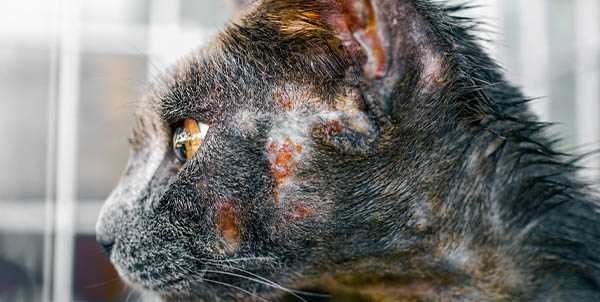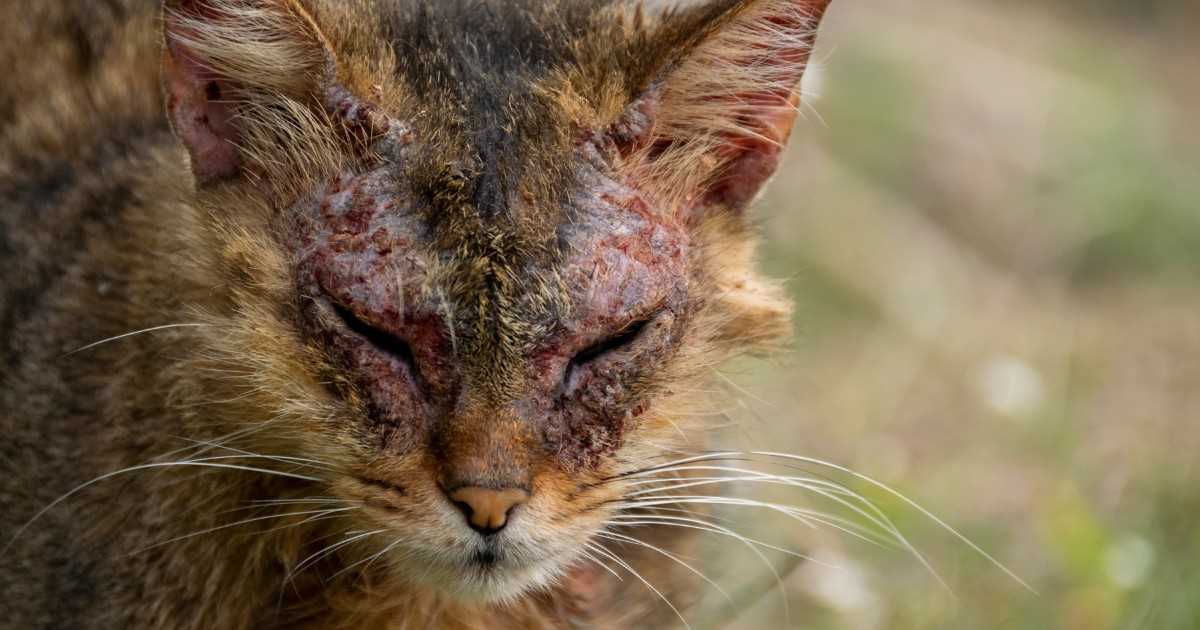



Experiencing skin issues can be alarming, especially if you notice unusual patches or hair loss. If you see red, inflamed areas or scabs, it may indicate a skin parasite presence. Skin irritation often appears as dry, flaky patches or raw spots, causing discomfort and itching.
Look for signs of excessive scratching or grooming, which can lead to further complications. If you observe these symptoms, seeking veterinary advice is crucial. A professional examination can determine the specific condition and appropriate treatment options.
Regular grooming and health check-ups can help in early detection of any skin-related concerns. Maintaining a clean environment and monitoring your pet’s behavior can also contribute to their overall well-being. Being proactive ensures a happier and healthier life for your furry friend.
Can Cats Experience Skin Mites and Their Symptoms
Skin mites can affect felines, leading to discomfort and various skin issues. Identifying signs early is key to effective intervention.
Common symptoms include:
- Intense itching and scratching
- Red, inflamed patches of skin
- Hair loss, often in patches
- Scabs or crusty areas on the skin
- Excessive grooming behavior
- Unpleasant odor from the skin
If you notice these indications, a visit to the veterinarian is essential for accurate diagnosis and treatment. Diagnosis typically involves:
- Physical examination of the skin
- Skin scrapings or samples for microscopic analysis
- Possible allergy tests to rule out other conditions
Effective treatment options may include:
- Topical treatments or medicated shampoos
- Oral medications to eliminate mites
- Improved hygiene in the living environment
Regular check-ups can help prevent infestations and maintain overall health. Keep an eye on grooming habits and skin condition to catch any issues early!
Understanding Types of Mange in Cats
Two primary forms of skin infestation affect my fellow felines: sarcoptic and demodectic. Each presents distinct challenges and symptoms.
Sarcoptic Infestation

This type originates from tiny mites, leading to severe itching and discomfort. Affected individuals often exhibit hair loss, particularly around the ears, elbows, and face. Skin may appear red and inflamed, with potential scabs forming due to excessive scratching. Veterinary intervention is crucial for effective treatment.
Demodectic Infestation
Typically associated with weakened immune systems, this variety of infestation manifests in localized patches of hair loss. Lesions often appear on the face and forelimbs, with less intense itching compared to the sarcoptic type. Diagnosis often involves skin scraping, and treatment may require medicated shampoos or topical solutions.
| Type of Infestation | Symptoms | Treatment |
|---|---|---|
| Sarcoptic | Severe itching, redness, hair loss | Veterinary medications, topical treatments |
| Demodectic | Localized hair loss, less itching | Medicated shampoos, topical solutions |
Identifying the specific type is essential for effective management. Regular check-ups with a vet can ensure early detection and treatment. Stay healthy!
Symptoms of Mange in Feline Friends
It’s crucial to recognize specific signs indicating the presence of skin parasites. Watch for excessive scratching or biting at the skin, which may lead to hair loss and inflamed areas. Redness and irritation can manifest, particularly around the ears, tail, and face. Observe for dry, scaly patches or crusted lesions, as these are telltale indicators of infestation.
In severe cases, weight loss may occur due to decreased appetite, as the discomfort affects feeding behavior. Behavioral changes such as increased irritability or withdrawal could also signal underlying issues. If you notice these symptoms, consult a veterinarian promptly for diagnosis and treatment options.
Additional Considerations
Maintaining a clean environment is vital. Regularly inspect your living space to minimize exposure to potential sources of infestation. For those seeking safe plants, check out the best house plants for cats to ensure a healthy home. Also, ensure grooming tools are sanitized to prevent spreading any skin conditions.
Lastly, understanding how different household items interact is essential. For instance, if you’re considering lawn maintenance, knowing are lawn mower batteries interchangeable can help you maintain your garden without causing harm to your furry companion.
How to Diagnose Mange in Cats

To confirm an infestation, observe for specific signs that indicate skin issues. A thorough examination is key. Look for patches of hair loss, redness, and excessive scratching.
- Inspect the skin for crusty lesions or sores.
- Check for any unusual odors emanating from the fur.
- Pay attention to changes in behavior, such as increased irritability or lethargy.
Collect samples of fur and skin debris for a veterinarian to analyze. They may perform a skin scraping test to identify mites under a microscope. This test is critical for accurate diagnosis.
Consider additional tests if necessary, such as a fungal culture, to rule out other skin conditions. Your vet might also recommend blood tests to assess overall health.
Acting quickly is vital. Early detection and treatment can prevent severe skin damage and complications. Regular check-ups can help monitor skin health and catch issues before they escalate.
Treatment Options for Mange in Cats
Topical treatments, including medicated shampoos and ointments, effectively target skin infestations. These products contain ingredients like permethrin or lime sulfur, which kill mites and soothe irritation. Regular application as per veterinary guidance can enhance recovery.
Oral medications, such as ivermectin or milbemycin, serve as an alternative for systemic treatment. These medications eradicate mites from within, often prescribed after a thorough evaluation by a veterinarian. Dosage and duration depend on the severity of the condition.
Environmental control is crucial. Regular cleaning and disinfecting of living spaces help eliminate any lingering mites. Washing bedding, toys, and grooming tools in hot water ensures a thorough cleanse. Avoiding close contact with other animals during treatment reduces the risk of transmission.
Supportive care plays a significant role. Providing a balanced diet rich in essential nutrients bolsters the immune system, aiding in the healing process. Ensuring a stress-free environment helps maintain overall well-being during recovery.
Follow-up visits to the veterinarian are necessary to monitor progress. Adjustments to treatment may be required based on response. Keeping an eye on symptoms and reporting any changes ensures a swift response to any complications.
Preventative Measures Against Mange
Regular grooming sessions are key. Brushing minimizes loose fur and skin debris, reducing the risk of infestations. Use a fine-toothed comb or brush designed for my type to ensure thorough cleaning.
Maintain a Clean Environment
Keeping my living space tidy is crucial. Frequent vacuuming and washing of bedding eliminate potential mites. A clean environment discourages the presence of parasites that could lead to skin issues.
Regular Veterinary Check-Ups
Routine visits to the vet help catch any early signs of skin problems. Vaccinations and preventative treatments can be recommended during these check-ups, ensuring a healthy coat and skin.
Minimize exposure to stray animals. Encounters with outdoor friends may increase the chances of encountering skin parasites. Supervised outdoor time is advisable, especially in areas known for these pests.
Lastly, maintaining a balanced diet supports overall health. Quality food strengthens the immune system, making it harder for parasites to take hold.
When to Consult a Veterinarian About Mange
If there are noticeable changes in my skin condition, such as excessive scratching, hair loss, or inflamed patches, it’s time to seek veterinary help. Unusual behaviors like constant licking or biting at certain areas also signal the need for professional evaluation.
Should there be any signs of secondary infections, such as pus or an unpleasant odor, immediate attention is crucial. A veterinarian can assess the situation accurately and provide appropriate treatment options.
When symptoms persist despite home remedies, scheduling a visit becomes necessary. Timely intervention is vital to prevent further complications and ensure a swift recovery.
Regular check-ups help monitor overall health, so if any new or concerning symptoms arise, don’t hesitate to consult a professional. Early detection often leads to better outcomes.
FAQ:
Can cats get mange?
Yes, cats can get mange. This condition is caused by microscopic mites that infest the skin. There are two primary types of mange in cats: sarcoptic mange, caused by Sarcoptes scabiei mites, and notoedric mange, caused by Notoedres cati mites. Both types can lead to discomfort and skin issues for the affected cat.
What are the symptoms of mange in cats?
Symptoms of mange in cats include intense itching, hair loss, redness, and inflammation of the skin. You may also notice scabs or crusts on the skin. In severe cases, the skin can become thickened and develop secondary infections. If your cat shows any of these signs, it’s important to consult a veterinarian for a proper diagnosis and treatment plan.
How can I tell if my cat has mange or another skin condition?
To determine if your cat has mange or another skin condition, look for specific signs such as itching, hair loss, and lesions on the skin. A veterinarian can perform a skin scrape to identify the presence of mites. Other skin conditions, such as allergies or fungal infections, may have similar symptoms but require different treatments, so professional evaluation is key.
Is mange contagious to other pets or humans?
Yes, certain types of mange can be contagious. Sarcoptic mange, for example, can spread to other animals, including dogs and humans, through direct contact. Notoedric mange is primarily specific to cats but may cause irritation in humans upon contact. If you suspect your cat has mange, it’s advisable to isolate them and consult a vet to prevent potential spread.
What treatments are available for cats with mange?
Treatments for mange in cats typically involve topical or oral medications that target the specific mites causing the condition. Your veterinarian may prescribe medicated shampoos, topical treatments, or oral antiparasitic medications. It’s essential to follow the treatment plan and monitor your cat’s progress, as some cases may take weeks to resolve completely.









